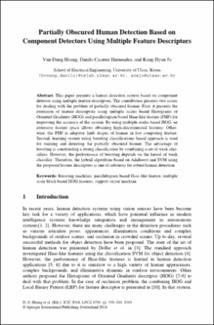| dc.contributor.author | Cáceres Hernández, Danilo | |
| dc.contributor.author | Hyun Jo, Kang | |
| dc.contributor.author | Dung Hoang, Van | |
| dc.date.accessioned | 2018-06-28T21:15:27Z | |
| dc.date.accessioned | 2018-06-28T21:15:27Z | |
| dc.date.available | 2018-06-28T21:15:27Z | |
| dc.date.available | 2018-06-28T21:15:27Z | |
| dc.date.issued | 2014-08-03 | |
| dc.date.issued | 2014-08-03 | |
| dc.identifier.uri | http://ridda2.utp.ac.pa/handle/123456789/5088 | |
| dc.identifier.uri | http://ridda2.utp.ac.pa/handle/123456789/5088 | |
| dc.description | This paper presents a human detection system based on component detector using multiple feature descriptors. The contribution presents two issues for dealing with the problem of partially obscured human. First, it presents the extension of feature descriptors using multiple scales based Histograms of Oriented Gradients (HOG) and parallelogram based Haar-like feature (PHF) for improving the accuracy of the system. By using multiple scales based HOG, an extensive feature space allows obtaining high-discriminated features. Otherwise, the PHF is adaptive limb shapes of human in fast computing feature. Second, learning system using boosting classifications based approach is used for training and detecting the partially obscured human. The advantage of boosting is constructing a strong classification by combining a set of weak classifiers. However, the performance of boosting depends on the kernel of weak classifier. Therefore, the hybrid algorithms based on AdaBoost and SVM using the proposed feature descriptors is one of solutions for robust human detection. | en_US |
| dc.description.abstract | This paper presents a human detection system based on component detector using multiple feature descriptors. The contribution presents two issues for dealing with the problem of partially obscured human. First, it presents the extension of feature descriptors using multiple scales based Histograms of Oriented Gradients (HOG) and parallelogram based Haar-like feature (PHF) for improving the accuracy of the system. By using multiple scales based HOG, an extensive feature space allows obtaining high-discriminated features. Otherwise, the PHF is adaptive limb shapes of human in fast computing feature. Second, learning system using boosting classifications based approach is used for training and detecting the partially obscured human. The advantage of boosting is constructing a strong classification by combining a set of weak classifiers. However, the performance of boosting depends on the kernel of weak classifier. Therefore, the hybrid algorithms based on AdaBoost and SVM using the proposed feature descriptors is one of solutions for robust human detection. | en_US |
| dc.language | eng | |
| dc.language.iso | eng | en_US |
| dc.rights | https://creativecommons.org/licenses/by-nc-sa/4.0/ | |
| dc.rights | info:eu-repo/semantics/openAccess | |
| dc.subject | Boosting machines | en_US |
| dc.subject | parallelogram based Haar-like feature | en_US |
| dc.subject | multiple scale block based HOG features | en_US |
| dc.subject | support vector machine | en_US |
| dc.subject | Boosting machines | |
| dc.subject | parallelogram based Haar-like feature | |
| dc.subject | multiple scale block based HOG features | |
| dc.subject | support vector machine | |
| dc.title | Partially obscured human detection based on component detectors using multiple feature descriptors | en_US |
| dc.type | info:eu-repo/semantics/article | |
| dc.type | info:eu-repo/semantics/publishedVersion | |
